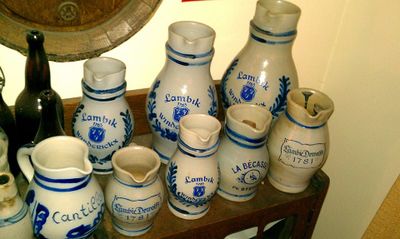Lambic pitchers and other stoneware

Overview
Many lambic drinkers are familiar with the blueish-gray hued clay pitchers that many lambic breweries use to serve their lambics. These pitchers come in a variety of sizes from half-liters all the way up to 3-liters, and are used both to serve lambic on draught as well as to decant bottles. Current breweries including 3 Fonteinen, Cantillon, Timmermans and closed breweries like Winderickx and De Wolfs all had their own versions of the stoneware. Several breweries including Winderickx also have their own branded stoneware mugs made in a similar fashion. Many of the pitchers that lambic producers use are a blue/gray or sandy-brown color.
Historical use
Pitchers were the primary vessel for serving lambic from the cask at lambic cafés throughout Belgium. Before bottling lambics was prominent, many cafés served their own blends and straight lambics directly from wooden casks behind the bar. To facilitate larger groups and quicker serving times many bars and cafés had these large pitchers.[1] Many believe that the first historical depiction of this stoneware being used for lambic (more specifically Faro) is in Pieter Bruegel's painting The Peasant Wedding (Le Repas de noce, French, De boerenbruiloft, Dutch).[2] Completed ca. 1567-68, the painting depicts a wedding ceremony in which stone pitchers are used for serving beer to guests. The painting is also used for the label of the U.S import version of Cantillon's Grand Cru Bruocsella
Today, Café A La Bécasse still serves lambics in these pitchers. Breweries like Cantillon, Timmermans, and 3 Fonteinen also still serve lambic in these pitchers. Though the evidence is only anecdotal, some believe that the use of pitchers as a decanter for highly aromatic beers like Cantillon's Mamouche helps to open the beer up in much the same way as a wine decanter.
Origins
The proper name for this style of pottery is Keulse pot or 'Cologne pot'. As the name suggests, this style of pottery originated in the Cologne area of Germany. The Keulse pot style carries on a tradition that dates back to the late-13th and 14th centuries in the Rhine River watershed. The town of Sieburg, Germany (30km from Cologne) is the first recognized center of this style of pottery. The pottery is characterized by its use of salt glazing to achieve both its glossy look and its waterproof finish and its strong cobalt blue finish which originated in Poland. [3] It is unclear when lambic producers specifically adopted and began to brand this stoneware with their own names, though examples from the early 20th century do exist.
The pottery ranges from pitchers, to jugs, to large pots of 20 to 30 liters. The larger pots were used primarily for storing vegetable and meat preserves after harvest. In Germany, Holland, and Belgium the pottery is commonplace and still produced today, though not generally used for the traditional preservation process.
References
- ↑ Jef Lambic, Les Memoirs de Jef Lambic, ~1955
- ↑ Raymond Buren, Gueuze, Faro, et Kriek, 1992
- ↑ History, Keulse Potten - http://www.historieroermond.nl/keulseaardewerk/keulseaardewerk.htm (Dutch)